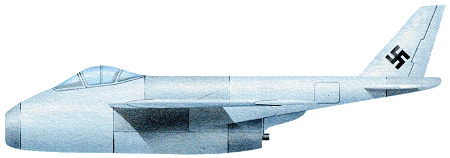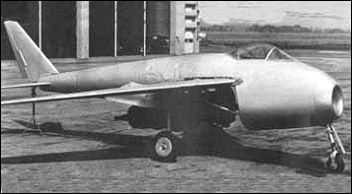|
| An experimental jet fighter capable of having its wings set at different angles of sweepback. It was never completed but influenced the post-war development of the Bell X-5.

 | A three-view drawing (800 x 438) |
| Worldwar2jets, e-mail, 03.10.2020 20:23 The Me P.1101 swept wing design was used on F86 Sabre. It also led to the Bell X-5 in the U.S to study variable sweep tech. The Me P.1101 design also ended up creating the Saab 29 tunnan.
The Ta 183 inspired the MIG 15 and Lavochkin La 15. The MIG was not original design at all as almost all russian jets by MIG, Yakovlev, Lavochkin had straight wings and a pod and boom design. The MIG 15 was designed using Ta 183 documents and also from MIG l-270 which was the captured German Me 263. reply | | Justin, e-mail, 19.04.2020 04:56 The MIG 15 is a combination of various German designs. The focke wulf ta 183 played a role in inspiration. The p1101 although falling in U.S hands it looks way to similar to the MIG 9. No coincidence. The Messerschmitt me 263 rocket plane also led to the MIG i270. I think all these aircraft designs played a role and once mated to the British turbo jet it was a winner. reply | | wanshan, 20.06.2011 12:02 many problems.
MiG-15 was not an evolution of any German aircraft but rather an indengenous design with an external resemblance of Ta-183 reply | | Aero99, 12.02.2011 20:14 This craft seems very similar to the MiG-9. Especially with the engine in the fusalgue. I wonder if these aircraft had a link together. reply | |
| | Maximiliano, e-mail, 13.04.2010 01:49 The soviet copy of the P1101 was a Sukhoi Su 9 but these airplane don´t has sweepback wings.
The MiG15 don´t has a occidental copy and Argentine Pulqui II grow up in the 4th prototipe like a good fighter and it wasn´t copy of the P1101 germany fighter. Look the triptic of 3 airplanes. reply | | bao, e-mail, 29.12.2009 05:31 This plane also having an influenced to Saab Tunan reply | | lookatthis, 19.10.2009 23:42 www.luft46.com /mess /mep1101.html reply | | fede, e-mail, 16.09.2009 19:43 jajaja pero en realidad el pulqui II fue un avion muy noble;) reply | | Gus,, e-mail, 12.02.2009 00:15 Sab�an que yo soy un idiota resentido que no tiene ni puta idea acerca del Pulqui I y II y opino estupideces en internet para sentirme importante...? reply | | Gus, e-mail, 02.01.2009 04:17 Hi, I agree with Nikos. Ta 183 ws not designed by Kurt Tank, it was designed by Hans Muldock, who worked later for the british after the war. Tank worked on a roughly inspired design on Ta 183 when he was in Argentina, the already mentioned Pulqui II, that resulted in a complete fiasco; it never performed better than Dewoitine�s Pulqui I. There were four prototypes of Pulqui II constructed in a period of nearly 4 years (50-53), and the first three were lost in accidents cause of the poor design (IIRC, Otto Behrens, the test pilot died; a few days before his death he said that the airplane was "the worst he had ever experienced as a test pilot").The project was initially halted in 1953, because an economic crisis and the fact that Tank and his team left Argentina, and finally cancelled with the fall of Per�n in 1955. In those times, 1953, even Migs 15 and F-86s were no longer busy in dogfights in the Korean sky.
It is absolutely true that Me P.1101 was later developed by Bell as the X5. reply | | Nikos J. Farsaris, 01.01.2009 19:29 If there was another plane evolved from Me-1101 that was Grumman XF-10 (indirectly thou, through Bell X-5) but also as a prototype only since its complexity led to many problems.
MiG-15 was not an evolution of any German aircraft but rather an indengenous design with an external resemblance of Ta-183 reply | | Stephen Spears, e-mail, 29.07.2008 20:48 The Ta-183 never got beyond the windtunnel model stage. No prototypes were ever built. The MiG-15 does use some capturred German research after WWII, but that's all. The North American F-86 Sabre did too. They first invisaged the F-86 as a straight wing fighter, that is until they found the research in Germany on swept wings. reply | | wuwu, e-mail, 16.07.2008 23:42 ohh poor people from west Europa... do you really thing that Mig-15 had to be a copy of west-cauntry construction?? first thing - The P.1101 was found by AMERICAN soldiers... second - Mi-15 was designed in the most advanced - it that time - aircraft labotatory called CAGI, the construction was much more advanced than P-1101... example: hermetic canopy, much better engine, quite diffrent fluseage-idea... etc etc... the similar things are: both were jet aircraft, both had wings and fluseage:) reply | | www.aviastar.org, e-mail, 06.07.2008 22:08 Some sources say that the famous Soviet MiG-15 was at least inspired by the Ta 183 due to the fact that the Soviets captured plans and prototypes for the Ta 183 from the Germans at the end of World War II. The MiG-15 has a superficial resemblance in layout though the planes are different in structure, detail shapes, and proportions. The MiG-15 shared the high tailplane, bubble canopy, and nose mounted intake and guns but these were common features of fighter designs of that era (for example, the Republic F-84B /F, the French Dassault Ouragan and Myst�re or the SAAB Tunnan). A detailed design history of the MiG-15 has been published by the noted Russian aviation historian Yefim Gordon which refutes any connection between the Ta 183 and the MiG-15 and shows the MiG-15 to be an entirely separate development.
from Wikipedia
en.wikipedia.org /wiki /Focke-Wulf_Ta_183 reply | |
| | Stephen S., e-mail, 13.06.2008 17:22 The MiG-15 is copied from the plans for the Ta-183, not the P.1101. The P.1101 went to the USA following the war. When it was captured by the Americans. This plane lead to the Bell X-5 experimental Variable Geometry plane. The first one of its kind to fly, and move its wings in flight. Unlike the P.1101, which couldn't because the Germans didn't have the technology to move the wings yet. The scientists were working on the gear that'd make it possible for the P.1101's pilot the adjust the plane's sweep in flight when the war ended. reply | | Alex, 28.04.2008 20:02 Neither, the correct genealogy leads to Kurt Tank's Ta-183 designed for Focke-Wulf. Compare the P.1101 to the MiG and throw in the I.Ae. 33 Pulqui II, another of Tank's designs, and you will see, that the three have much more in common, than any of them have with the Messeschmitt design. The general layout was obvious of the time, because it was difficult to calculate the airflow through twisted ducts. Therefor almost all contemporary designs share the "open nose" and straight through flowpath. reply | | p, e-mail, 01.03.2008 13:21 The MIG-15 is copped from this plane P.1101 reply | | Stefan, e-mail, 08.09.2007 19:30 Both!
Stefan reply | | Sgt.KAR98, 15.12.2006 03:07 This plane origined the MiG-15 or the F-86 Sabre? reply |
|
Do you have any comments?
|
| 
COMPANY
PROFILE
All the World's Rotorcraft
|








